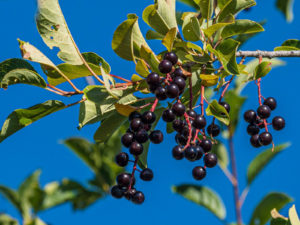Season 3
Season 2
Season 1
Time of Chokecherry
The Methow Valley Interpretive Center in Twisp, WA presents “Notes from the Center” (Episode 5): Time of Chokecherry. Join David LaFever as he introduces nselcin (Okanogan language) words for important cultural plants ripening at this time, including chokecherry, huckleberry, foamberry and blue elderberry.
Just as the dog days of summer catch up with us, with its oppressive heat and sometimes smoky haze, we are offered the gift that, if preserved well, will keep on giving throughout cold dark times ahead. This is the Time of Chokecherry or łəx̌ʷłax̌ʷtan, in Nsəlxcin, also known as the Okanogan or Northern Interior Salish language. Nsəlxcin, or a dialect of it, is spoken by several local tribes including the mətxʷu (Methow), uknaqín (Okanogan), snʕáyckstx (Lakes), sx̌ʷyʔiɬp (Colville), nspilm (Nespelem), and sənpʕʷilx (San Poil).A member of the rose family, łəx̌ʷłax̌ʷ (chokecherry) is found across most of Canada, most of the United States, and northern Mexico, and can be found in open forests, grasslands, and dry, rocky sites.łəx̌ʷłax̌ʷ is an important food and medicine for peoples across North American including the metxʷu and other local tribes. Traditional ways to eat and preserve chokecherries are fresh eating, mashed fresh and sundried into thin cakes, sundried separately like raisins, pounded and combined with salmon heads, tails and eggs or boiled and combined with salmon or meat. My favorite way to preserve chokecherries is to make chokecherry jam and I sometimes combine them with elderberries for a delicious and healthy elixir-of-summer anytime of the year. Beware that the seeds and other parts of the plant contain cyanide which should not be consumed in large quantities. Cyanide is thought to be a response to herbivory by deer and other browsers and acts to protect chokecherry.I encourage you to head out, pay attention and see what the Time of Chokecherry is all about. When do they ripen and where? What other plants are fruiting at this time? What animals meet you at your favorite chokecherry spot? Gather some and try different ways of preserving them – sundried cakes, mixed with butter, coconut oil or bacon fat? Boil some and mix them with salmon or meat and see what you think.Remember and honor this time of year as łəx̌ʷłax̌ʷtan, Time of Chokecherry, and allow that knowledge to connect you even deeper with the Methow Valley or wherever you happen to be. Through doing so we are connecting with an ancient practice of giving thanks and honoring this time of year. As we slather chokecherry jelly on a piece of toast on a cold morning this winter, let summer’s heat warm our hearts and minds, and let us be thankful for all that we have.
Honorable Harvesting Practices:
- Know when to harvest.
- Don’t take the first.
- Don’t take the last.
- Give something in return.
- Ask for permission, give thanks.
*For more depth on honorably harvesting see Rosalee de la Foret’s newest book Wild Remedies (Chapter 4) and Robin Wall Kimmerer’s book Braiding Sweetgrass (Chapter titled “The Honorable Harvest”).
How to Make Chokecherry Jelly
Jelly is made from fruit juice and sugar and will only achieve a jelly-like structure when it contains sufficient pectin (which can be added or extracted from fruit itself).
Extracting juice from the chokecherries:
*One pound of chokecherries will give close to 2 cups of juice
- Wash the fruit in cool running water.
- Place chokecherries in a stainless steel or enamel pot, cover with water and simmer for 20-35 minutes or until soft.
- Let this cool and strain through cheese cloth or fine meshed strainer OR Smash through a colander
*You can also extract the juice using a steam-juicer (which are amazing to use).
* When extracting juice from chokecherries do not crush the seeds which contain cyanide.
Making the jelly:
Ingredients: 3 ½ cups chokecherry juice, 4 ½ cups of sugar, 1 ¾ ounces of pectin
- Pour chokecherry juice into a large heavy pot. Add pectin and stir to mix.
- Place over high heat and bring to a boil, stirring constantly.
- Stir in sugar. Bring to a full, rolling boil and boil for 1-2 minutes. Stir constantly.
- Remove from heat. Stir and skim off foam.
- Pour or ladle jelly into hot, sterilized half-pint or pint jars to ¼ inch of the top. Wipe rim of jars with a clean cloth. Seal with two-piece canning lids.
- Process in a boiling water bath for approximately 10 minutes.
- Cool, undisturbed for up to 24 hours.
- Store in a cool, dark place and enjoy!

